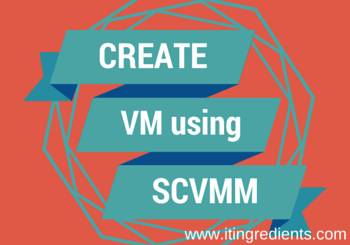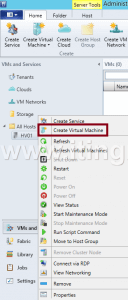How to Create VM using System Center Virtual Machine Manager 2012 R2
How to create VM using System Center Virtual Machine Manager 2012 R2
System Center Virtual Machine Manager (SCVMM) 2012 R2 is a tool from Microsoft used to manage Hyper-V servers and virtual machines. In this article, we’ll learn the steps to create VM using System Center Virtual Machine Manager 2012 R2. It can be used as a single console used to manage Hyper-V servers and private cloud. In earlier articles, we learned the steps to install Hyper-V server and steps to install SCVMM 2012 R2. If you are not using SCVMM then you can directly create Virtual Machine using Hyper-V Server.
Steps to create VM using System Center Virtual Machine Manager 2012 R2
1. Double click on the icon of Virtual Machine Manager console or click on Start button, click on down arrow and select SCVMM console. Enter the Server name and select the “Use current Microsoft Windows session identity” to use the current session credentials or click on “Specify credentials” for connecting to SCVMM console with different credentials. In this scenario, we are connecting to the local server (VMM01) using 8100 port with the current credentials of the administrator.
2. Before we create VM using System Center Virtual Machine manager 2012 R2, we need to add the ISO image of OS that we need to install. To import ISO image, on “Virtual Machine Manager” console, click on Library and then click on import physical resources from the server.
3. On “Import Library Resources” console, click on “Add resource” to import resource items. Browse the ISO image for importing. Here, we are importing the iso image of Windows Server 2012 R2 operating system.
4. Once you import the ISO image, on “Virtual Machine Manager” console, right click on the Hyper-V server under “VMs and Services“, and click on “Create Virtual Machine” or from the top menu click on “Create Virtual Machine” to create VM using System Center Virtual Machine Manager 2012 R2.
5. On “Select Source” console, either select “Use an existing virtual machine, VM template or virtual hard disk” as a source for the new virtual machine or select “Create the new virtual machine with a blank virtual hard disk “. In this example, we don’t have any existing VM, VM template or Virtual hard disk therefore we’ll select an option “Create the new Virtual Machine with a blank virtual hard disk” and click on Next to continue.
6. On “Specify Virtual Machine Identity” console, enter the name of the new machine, enter the description (optional) and select the generation. Click on Next for continuing this process. In this practical, 2k12-01 will be the name assigned and this VM is of Generation 2. For Generation 2 VM, machine should have an OS of Windows Server 2012 R2 or later.
7. On “Configure Hardware” console, under Compatibility select Hyper-V to make this virtual machine compatible of Hyper-V. As per your requirements, you can even define the Processor, Memory, Network Adapters, etc.
8. Under Bus configuration, select “Virtual DVD drive” and then select the option of “Existing ISO image” and then click on Browse to specify the ISO image through which we can install the operating system on this virtual machine.
9. To create VM using System Center Virtual Machine Manager 2012 R2, on “Select ISO” console, select the iso image from the available ISO images listed on this console. Here, we will select the ISO image of Windows Server 2012 R2 and click on OK.
10. On “Select Destination” console, select “Deploy the virtual machines to a private cloud” to place this virtual machine on a private cloud. Select “Place the virtual machine on a host” to deploy this virtual machine on any host listed in the all hosts tab. Or select “Store the virtual machine in the library” for using it later. But before powering on the virtual machine placed in a library we have to either deploy it on a host or a cloud. Click on Next to continue.
11. On “Select Host” console, select the destination i.e. Hyper-V server on which Virtual Machine would be hosted. If you have added multiple Hyper-V servers in SCVMM then you can see all of them over here. For this example, we are deploying virtual machine to HV01.itingredients.com. Click on Next.
12. On “Configure Settings” console, specify the storage location to store virtual machine’s files. For this example, we have defined the path “C:\VM”. This path is for Hyper-V server i.e. HV01.itingredients.com. Click on Next to continue.
13. On “Select Networks” console, specify the network adapters which can be used as virtual switches for virtual machines or click on next to continue. For this example, we are not using any.
14. On “Add Properties” console, select the action to perform automatically when the virtualization server starts, from the available options in the drop-down menu. Here, we are selecting the option of “Don’t turn on the virtual machine“.
15. Select the action to be performed when the virtualization server stops, from the available options. We are selecting the option of Save State to be performed when the host server stops.
16. Specify the operating system we have to install. Here, we are selecting the “Windows Server 2012 R2 Standard” and click on Next to continue.
17. On “Summary” console, confirm all the settings selected on previous consoles and click on Create to create the VM. You can even select the option “Start the virtual machine after deploying it” if you want to start VM automatically after deploy.
18. On “Jobs” console, we can check all the settings and status of creating the virtual machine. For this example, we can see that all the jobs are completed successfully. 
19. On “SCVMM” console, under All Hosts click on HV01 to see all the virtual machines hosted on HV01.itingredients.com. Click on the machine which you want to start and then click on Power On to power on the VM.
20. Once the VM is started, you can connect to VM. To connect to the virtual machine through a console, click on Connect to View and then click on Connect via Console.
21. On “Virtual Machine Viewer – 2k12-01 on server HV01.itingredients.com” we can see the console of VM i.e. 2k12-01 which is hosted on Hyper-V server (HV01).




















